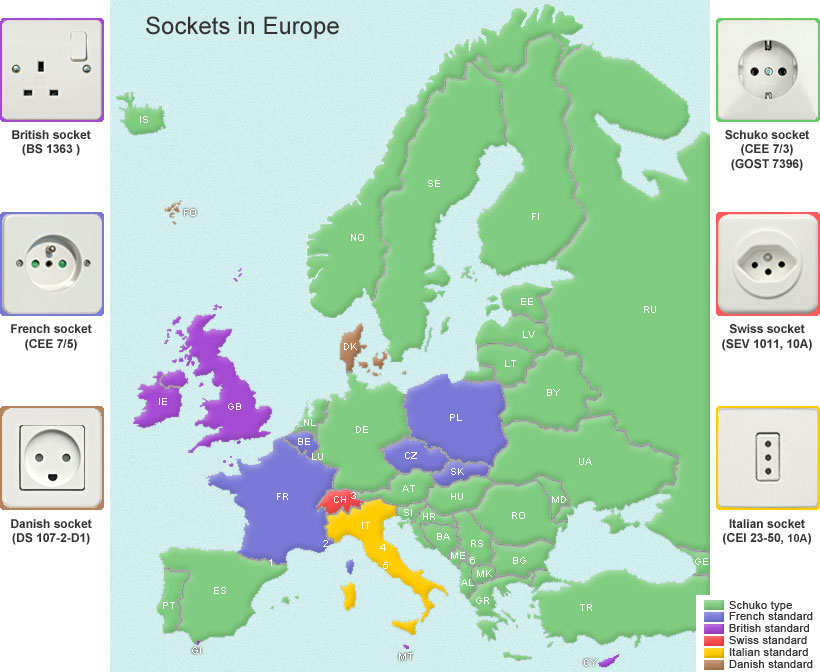 |
Plugs and Sockets in Europe map and compatibility table |
info page |
 |
Plugs and Sockets in Europe map and compatibility table |
info page |
| In Europe you can
find six different types of domestic sockets, see map below. One standard on the British
Isles, Cyprus, Malta and Gibraltar,
and five continental European
standards. These five differ from each other with regard to the earthing system. Non-earthed Europlugs can be used in any continental
European country. The British BS 1363 standard is fully different
from any other type. A table gives details about the compatibility of 22 types of earthed and non-earthed household plugs, and the six European types of sockets. Note the difference between 220-240V, 50 Hz mains in Europe and 110-125V, 60Hz in North America and Japan. |
| Standardization
in Europe ? A quick look at the map of Europe shows that the CEE 7/4 (Schuko) standard is most popular. According to population, about 250 million people within the European Union (EU) and another 225 million elsewhere in Europe are using Schuko plugs and sockets. Approximately 49% of people in the EU rely on Schuko, whereas the proportion of other standards is 25% French, 13% British, 12% Italian and 1% Danish. These figures seems to support the conclusion that Schuko is the prime candidate for an EU wide plug and socket standard. However, there are serious technical, sentimental and financial obstacles. The non-polarized nature of the Schuko design is a safety issue. A safe alternative could be the French standard, but European countries are inclined to be loyal to their own system. To avoid giving preference to any system the International Electrotechnical Commission has proposed in 1986 a new type of safe and handy-sized plugs and matching socket (see IEC 60906-1). A noble initiative, but its realization will cost a fortune and will take decades. Despite the remarks above, Schuko plugs have become the de facto - but not officially recognized - standard across most* of the countries within the European Union, because: (1) the CEE 7/7 hybrid Schuko/French plugs (see table below) are fully compatible with both Schuko and French type sockets; (2) Italy has developed a type of socket suitable for both traditional Italian and Schuko plugs (see CEI 23-50, Universal socket); (3) Denmark is allowing French standard sockets from July 2008 and Schuko from 2011. * except: UK (left EU in 2020), Ireland, Cyprus, Malta and Gibraltar (using BS 1363 standard). Switzerland, not an EU country, has its own standard. Russian GOST 7396 Group C defines plugs that closely resembles CEE 7/4, /6, /7, /16 and /17. They are also used in Belarus and Ukraine. |
 |
|
Countries and autonomous regions in Europe
are indicated by their 2 digit ISO 3166-1 standard code.
AL:
Albania; AT: Austria; BA: Bosnia - Herzegovina; BE: Belgium; BG:
Bulgaria; BY: Belarus; CH: Switzerland; CY: Cyprus; CZ: Czech Republic;
DE: Germany: DK: Denmark; EE: Estonia; ES: Spain; FI: Finland; FO:
Faroe Islands; FR: France; GB: United Kingdom; GE: Georgia; GI:
Gibraltar; GR: Greece; HR: Croatia; HU: Hungary; IE: Ireland; IS:
Iceland; LT: Lithuania; LU: Luxemburg; LV: Latvia; MC: Monaco; MD:
Moldova; ME: Montenegro; MK: Macedonia; MT: Malta; NL: Netherlands; NO:
Norway; PL: Poland; PT: Portugal; RO: Romania; RS: Serbia: RU: Russia;
SE: Sweden; SI: Slovenia; SK: Slovakia; TR: Turkey; UA: Ukraine.
1= Andorra (AD, Schuko); 2= Monaco (MC, type French); 3= Liechtenstein
(LI, SWiss); 4= San Marino (SM, Italian); 5= Holy See
/ Vatican City (VC, Italian); 6 = Kosovo (KV, Schuko).
|
| Footnote re. Italy: CEE 7/4, 7/7 and 7/17 plugs are compatible with a new Italian type of socket that also accepts Schuko plugs. |
|
|
|
|
|
|